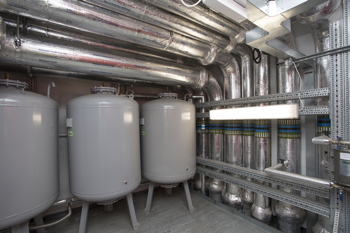Quality inside and out

Carl Davison considers the role of building services in helping to address the challenge of air quality and its impact on human health.
In 2016, the Royal College of Physicians estimated that health problems associated with poor air quality cost Britain over £20 billion per year. Indoor air quality in particular is known to disproportionally affect many of the most vulnerable parts of our community as they are less able to get outdoors. The building services sector has a vital role to play in addressing this issue in both new and existing buildings.
Research shows that proper ventilation, both mechanical and natural, can help to significantly reduce the risks posed by indoor pollutants such as volatile organic compounds (VOCs). However, an effective indoor air quality plan should also consider the use of materials which are known to be low VOC emitters. The Eurofins Indoor Air Comfort certification offers a useful tool for specifiers, confirming that certified products have displayed compliance with the relevant requirements of leading industry standards such as BREEAM, LEEDv4 and EMICODE.
 |
| Pipe insulation from Kingspan that has been awarded the Eurofins Comfort Gold certificate |
It is estimated that the average European spends around 87% of their working day indoors . A growing body of evidence has suggested that air quality within these environments can have a serious impact on the health of occupants. Whilst steps have been taken to deal with the most obvious pollutants such as smoking, homes and workplaces are still being filled with other pollutants such as volatile organic compounds (VOCs).
VOCs are found in a range of materials including cleaning and building products, carpets and paints. Under the ‘Volatile Organic Compounds in Paints, Varnishes and Vehicle Refinishing Products Regulations 2012 (VOC Regulations 2012)’, they are defined as compounds with a boiling point of 250°C or lower at a standard atmospheric pressure of 101.3 kPa. The low boiling point of these compounds causes large numbers of their molecules to enter the surrounding air at standard room temperatures.
VOCs have been linked with a variety of health issues including shortness of breath, dizziness, headaches and damage to internal organs and the central nervous system depending on the length and concentration of exposure. Whilst the legal limits for the VOC contents of materials are set within the VOC Regulations 2012, these cover only solvent and water-based products. With research showing that significant levels of VOCs are present in environments such as nurseries , it is vital that all products which can emit VOCs are properly assessed. One of the most rigorous standards currently available is the Eurofins Indoor Air Comfort Gold certification.
Two tier
The Eurofins Indoor Air Comfort certification programme harmonises the criteria of mandatory and voluntary product regulations from across Europe which govern VOC emissions. The voluntary certification tool is split into two levels.
Standard Certification - This shows that a product’s emissions are compliant with the minimum legal specifications issued by authorities and governments within the European Union.
 |
|
Eurofins certified products help safeguard the long-term health of occupants Image courtesy of EIC |
Gold Certification – This recognises the product is compliant with many of the most demanding voluntary performance standards and can be recognised as being an outstanding material according to the VOC Indoor Air Quality emissions regulations. Products with this certification achieve an A+ under the French VOC Regulations, a pass under AgBB, and compliance under the relevant sections of both BREEAM and LEEDv4 on European projects including the UK.
In order to achieve Eurofins Indoor Air Comfort Gold certification, production facilities are first assessed by an independent inspector approved by Eurofins. The assessor looks at all factors which may affect emissions from the product, including archival changes in a product’s formulation which may impact its performance. During the inspection, samples of products are taken for emissions testing.
The testing is completed in a steel chamber designed to the specification in CEN/TS 16516. Air sampling and measuring is performed after 3 days and 28 days using the procedures and parameters specified in CEN/TS 16516, ISO 16000-3 and ISO 16000-6. To pass, air concentrations must not exceed set limits. For example, the Eurofins Indoor Air Comfort Gold limiting values for pipe insulation materials are shown in the table.
Once emissions testing is completed, the results are then sent to the manufacturer along with a detailed report from the inspection, allowing corrective action to be taken where necessary. If the test results suggest compliance and no issues are raised in the inspection report then the product is issued with certification.
| Indoor Air Comfort Gold | After 3 days | After 28 days |
| TVOC (CEN/TS 16516) | 1000 µg/m³ | 100µg/m³ |
| RB Value (using Belgian LCI Calues) | - | 1 |
| RD Value (Using German LCI values) | - | 1 |
| Sum of VOC without German LCI and non-identified VOC | - | 100µg/m³ |
| TSVOC | - | 20 |
| Sum of detectable carcinogens (C1A, C1B) | 10µg/m³ | - |
| Any individual detectable carcinogens (C1A, C1B) | - | 1µg/m³ |
| 4 CMR substances specified in French regilations, each | - | 1µg/m³ |
| French VOC emissions class | - | A+ |
| Formaldehyde | - | 10µg/m³ |
| Acetaldehyde | - | 200µg/m³ |
Critically, Eurofins requires manufacturers to engage in a process of continuous testing and auditing. Recently certified products are subjected to emission testing and production site inspections every year to ensure low emissions. For longer term certified products and manufacturing facilities, this can be extended to once every two years. As a result, installers and specifiers can have confidence that the performance and quality of certified products will be maintained over time.
Work is under way to consider VOC emissions within the harmonised European Standards for the CE Marking of products and a growing number of building services products have now achieved the Gold Level of certification.
BREEAM update
It is worth noting that with the rise of healthy building methods, many building performance standards are now placing greater emphasis on IAQ.
In March, BRE unveiled an updated version of BREEAM New Construction UK. The revised standard makes the completion of an indoor air quality plan a pre-requisite for achieving any credits within the Health & Wellbeing - HEA 02 subsection. In addition, there are now two credits available for specifying low-VOC compliant materials and the scope of assessment has been widened to include a number of additional products. Specifiers should consider Eurofins Indoor Air Comfort Gold certified options when identifying products.
It is essential that an effective ventilation strategy is developed for airtight buildings. Indoor air quality planning should form a natural part of this process. The Eurofins scheme provides a tool for specifiers to find products with low VOC emissions to form part of a holistic solution which effectively safeguards the health and wellbeing of building users.
Carl Davison is technical services manager at Kingspan Insulation







